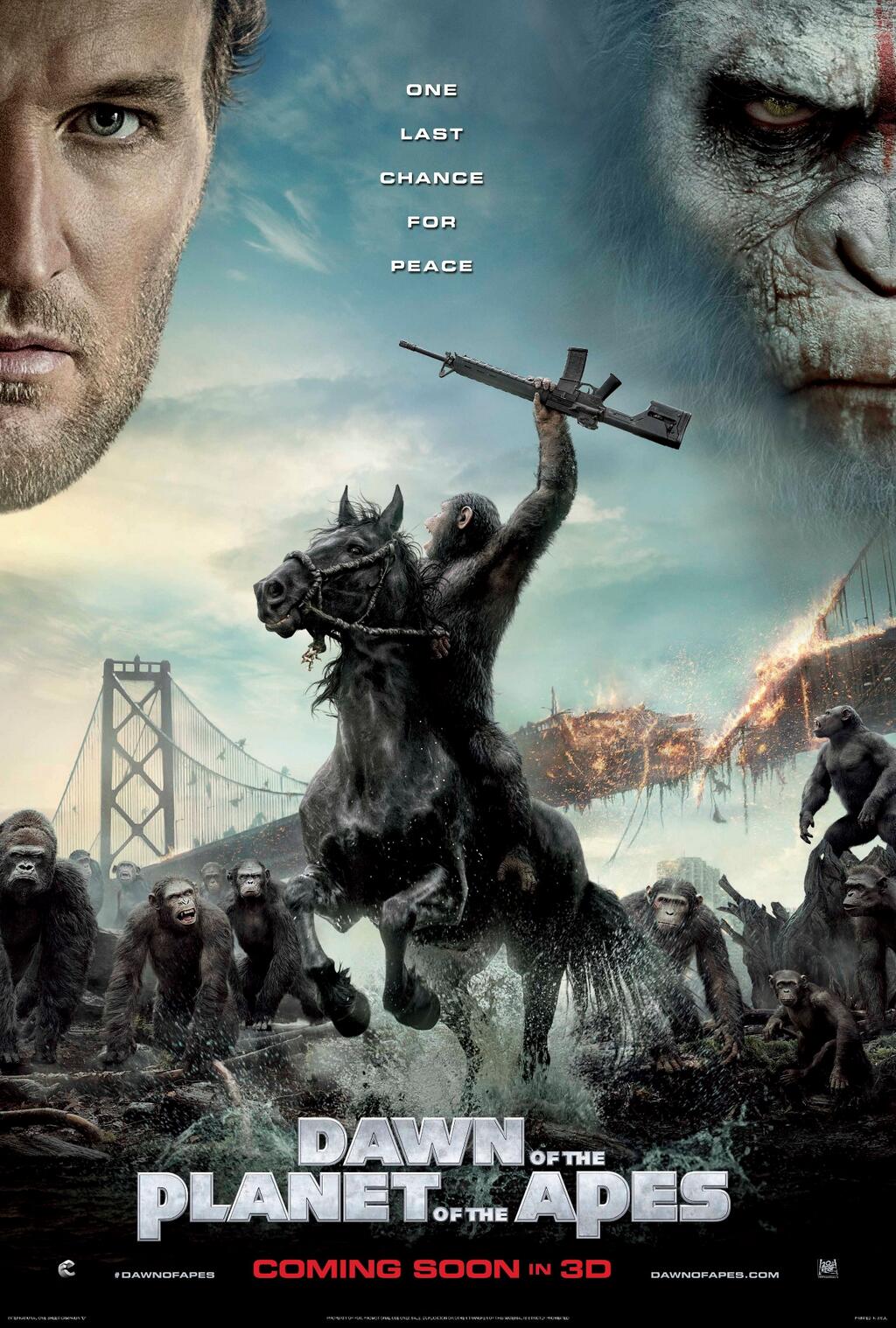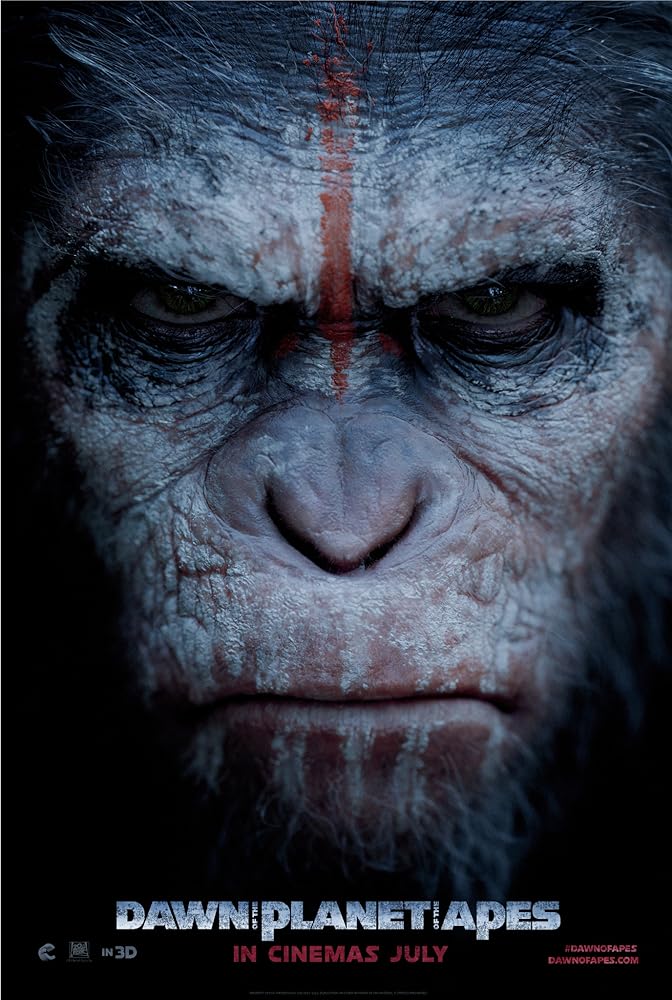INTRO
War
is created from two opposing forces and each person must choose a side to support.
Either “us” or “them.” Throughout history, the “us” verses “them”
mentality established among cultures has created conflicts that can lead to
violence and war. Massacres of Native Americans were carried out by the U.S.
Military during the western expansion. Hitler’s genocides killed millions of
Jewish followers during the second World War.
In
our Western culture, many of our films do not stray from the easily understood
“us” and “them” battle. For instance, James Cameron’s Avatar pits the profit hungry humans of Earth against the nature-loving, traditional Na’vi of Pandora in a battle over resources and a homeland.
Likewise, in Matt Reeve’s Dawn of the
Planet of the Apes, both humans and apes strive to survive on a vastly
different version of Earth. So the character clings to their own, familiar culture and fights against the "other" out of fear.
Either
way, inevitable violence explodes in both films. But why is violence among
these species seen as the only feasible solution? Again, this all circles back
to the means in which Western History was shaped: with an imperial mindset. As
a culture, it was ingrained in us to see another culture as an “other” and if
they pose the slightest threat or obstacle, force is the simplest solution.
THESIS
Therefore,
the films Avatar and Dawn of the Planet of the Apes feature
themes of post-colonialism and the violent effects an “us versus them” relationship among
cultures has on the individuals within them.
OUTLINE
How the conflicting cultures of Avatar and Dawn of the Planet of the Apes contrast with each other:
· Dimensions of National Cultures as defined by Geert Hofstede
- According to Hofstede, culture is “the collective programming of the mind distinguishing the members of one group or category of people from others.”
- There are six dimensions, but the dimensions that fuel most of the conflicts seen in these films are Masculinity versus Femininity, Uncertainty Avoidance and Long Term Orientation.
- Masculinity versus Femininity focuses on a culture’s preference to strive for personal achievement or to nurture the community as a whole (Hofstede)
- Uncertainty Avoidance concerns the degree to which members of a culture feel comfortable taking risks. Cultures with low uncertainty avoidance will be more likely to take risks. (Hofstede)
- Long Term Orientation expresses quickly or slowly a culture wishes to complete its goals. Cultures with a higher long term orientation are willing to take their time. (Hofstede)
· Comparing Avatar’s Humans and Na’vi
- Contrast in Masculinity and Femininity
- Human culture is more focused on achievement, making them masculine. They strive to mine unobtainium and are willing to strike down the Na’vi in order to do so. (Cameron, Avatar)
- The Na’vi are focused on “The People.” Their actions focus on what will better the tribe rather than the individuals. (Cameron, Avatar)
- Contrast in Uncertainty Avoidance
- The humans are more willing to risk destruction and violence in order to get what they want. Several characters express indifference when the Home Tree of the Na’vi becomes an obstacle. (Cameron, Avatar)
- Na’vi are not as well accustomed to change or willing to take chances. They are more traditional as seen in how well connected to their ancestors they are. (This can be seen in their tie to the tree of souls.) They only choose to take chances when their entire culture and lives are on the line. (As seen when they are preparing for the final battle.) (Cameron, Avatar)
- Contrasts in Long Term Orientation
- Humans want results immediately. Early on in the film, Parker Selfridge mentions the need to have profitable results for the upcoming quarter. (Cameron, Avatar)
- Relating back to the culture’s feminine quality, the Na’vi are not as focused on immediate results. They are willing to let things flow with the way of Eywa. (Cameron, Avatar)
- Much of the conflict between the humans and Na’vi is rooted in these difference in cultural dimensions which fuel their actions. The humans who strive for achievement use force to get the unobtainium because they need results as soon as possible. On the other hand, the Na’vi have no need for profit and choose to focus on their people by sticking with traditions and letting Eywa be their guiding force.
· Comparing the humans and apes in Dawn of the Planet of the Apes.
- Due to the ape-pocalypse and the mass devastation of the human race, the human culture seen in this film is vastly different from the one previously seen in Avatar. Instead of seeking expansion on another planet, the humans simply strive for survival. Because of this difference, the ape and human cultures have more similarities than differences.
- Both are more Feminine.
- The Ape community has just begun to thrive and the humans have come together to try to survive. Both cultures are centered on the people of each culture because their races depend on cooperation to survive.
- Both have a lower Uncertainty Avoidance
- Humans are high risk takers because they are on at the end of their rope. They are willing to risk their lives to fix the dam in order to get electricity that will save their community in San Francisco. (Reeves, Dawn)
- This dimension is difficult to apply to the ape culture because it depends heavily upon the ape. Koba is a huge risk taker since he is willing to kill Caesar, the ape who saved him, in order to rid the Earth of humans. Caesar has a high uncertainty avoidance at first since he looks out for the betterment of the apes. However, when faced with the conflict with Koba, he is more willing to risk his life to salvage the community he has created. (Reeves, Dawn)
- Both have a lower Long Term Orientation
- Humans are faced with a life or death situation. They need power to live and reach out to other survivors. Therefore, they require immediate results.
- This is another dimension not easily applicable to the apes. Caesar far more concerned with long term orientation. This can be seen in his decision to allow the humans to work on the dam as well as his reluctance to fight them. Meanwhile, Koba is focused on current situation with the humans. His past is what drives him to fight without much concern for the distant future. (Reeves, Dawn)
- Where is the conflict between these cultures rooted?
- What is seen in this film is a reverse in imperialism.
- The Funk & Wagnalls New World Encyclopedia defines imperialism as the “practice by which powerful nations or peoples seek to extend and maintain control or influence over weaker nations or peoples.”
- The once conquered apes become the conquerors as Koba leads his army to take over what is left of San Francisco.
- Koba strikes out of fear of past events with humans.
- “Koba’s actions [are] neither random or unjustified. His […] violence […] responds to the violence that has already been done to the apes” (Hamilton, 318).
What does this say about Western Culture?
It reflects elements of Post-Colonialism.
- As stated before, elements of imperialism are apparent through Dawn of the Planet of the Apes.
- In a strange twist of events, the apes attempt to exert imperialism over the humans.
- They take advantage of their weakened state and exert force over them.
- As a response to fear for humans, apes (Koba in particular) show off their power and dominance.
- Avatar contains imperialism as well, but also Orientalism.
- According to Edward Said, Orientalism is closely tied to imperialist cultures.
- Orientalism is the patronizing and misrepresentation of another culture through the eyes of the imperial culture.
- This is seen through the scientists on Pandora who try to look at the Na'vi "objectively."
- Avatar chooses to "problematize settler culture's configuration of the 'sacred,' distinguishing indigenous knowledge as objects of colonial scientific study from that of a mode of living." (Chou, 79).
- Also, through the human's need to mold the Na'vi to fit their standards.
- Grace taught many of the Na'vi English and they once tried to offer them medicine (which they refused).
· It reflects the Western Culture's relationship with violence.
- Violence is used as a means of recognition of personhood.
- The ape’s violence “becomes the deliberate and calculated violence of political subjects, dined rights, and asserting them forcefully against an unjust sovereign” (Hamilton 317).
- Western History with violence is reflected in our entertainment
- Audiences have a thirst for war
- In his review of Dawn of the Planet of the Apes, Richard Corliss explains that the film “dares ask the audience to root for the peacemakers” referencing Malcom and Caesar. However, he later states that in the end, the viewers crave for blood.
- Audiences have Western Colonial Guilt
- Western culture has guilt about colonialism and the means by which these countries expanded.
- John Rieder explains how films like Avatar exploit this Western guilt. He states “Avatar mystifies race and violence, representing the heroes’ own participation in the same project as the villains in order to afford these heroes all the rewards of colonialism with none of the guilt” (47).
CONCLUSION
The amount of violence in films today is enough to tell modern audiences how heavily war and fighting has influenced the Western culture. It is pivotal to Western history and has greatly shaped the entertainment industry. Perhaps there is a way to quench an audience's thirst for gore and blood that does not force cultures to view one another in a negative light.








